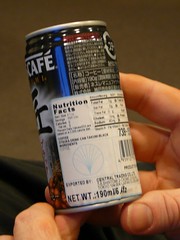A couple of weeks ago I wrote about using metrics and data as a means of measuring and motivating the effort to get in shape.

- Image by mlcastle via Flickr
One morning as I was grabbing a coffee from the local Peet’s I saw they had a nutritional l information card available, listing out the caloric, fat, and other nutritional information about their offerings. I think this is great.
Now I’m pretty sure that they are required to provide this by law but I was still impressed that it was available right there on the counter and the information is provided in a very clear, easy to digest (pun slightly intended) fashion.
I usually only stop in for a coffee in the morning, so I’m not too concerned about the nutritional information there (I get a half decaf so I’m not worried about the caffeine either). What I am interested in is the foods that they provide. Peet’s is my go-to place when I’m out of milk, etc., and have to grab breakfast in the morning before heading in to work. I’ve often wondered: am I better off with the bran muffin, the blueberry muffin, the currant scone, or should I skip this and have more protein like option of an egg on a muffin over at the Lee’s Deli.
According to the guide (which for obvious reasons doesn’t provide insight into Lee’s food), the scone gets me 480 calories (as does the blueberry muffin) while the whole wheat honey bran muffin gets only 390 calories. So there’s not a whole heck of a lot of difference (and all fall within a reasonable number of calories for me, if that’s all I’m having for breakfast). Now fat on the other hand clearly points to the bran muffin, coming in at less than 1/2 the fat of the other options.
What’s really interesting to me though is the disparity between the lowfat options and the ‘regular.’ Many of the “low fat” options have nearly as many calories and in many instances, more fat than some of the ‘regular’ items like that bran muffin.
It just shows that it takes time and effort to figure all of this out – and in the long run it’s probably worth taking the extra moments to think about what we’re eating.


